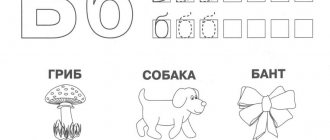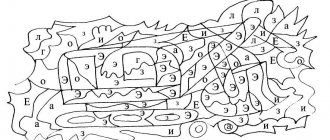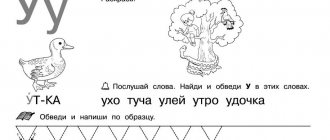Additional exercises
For the development of the speech apparatus, exercises not related to articulation are also useful - tasks for fine motor skills and finger games. Well-developed fine motor skills have a beneficial effect on the development of children's speech.
Exercises:
- Grasping movements. The child grabs objects of different shapes (ball, rattle, cube) with the palm of one hand or two hands, then with three fingers (pinch) and two fingers - the thumb and forefinger (tweezer grip).
- Correlating actions are the combination of two objects or components of one, for example, a nesting doll or a pyramid. To practice such movements, you can simply tear pieces of paper.
- Development of fine motor skills in babies up to one year old with the help of massage.
- Various finger movements. Ask your child to show various figures with his fingers, for example, a wolf, a bunny, a chair, a house. At first, the child's movements will be clumsy, but over time they will become more precise and dexterous. It is also important that the preschooler be able to imitate the movements demonstrated by an adult.
The development of fingers is promoted by:
- fastening and unfastening zippers, snaps, buttons when putting on and taking off clothes, so this is something that the baby must do himself;
- all possible assistance to adults, for example, watering flowers and wiping their leaves with a sponge, wiping off dust, cleaning clothes with a brush (a child can perform such tasks from the age of three);
- design, appliqué, modeling, drawing, making toys with your own hands.
There are special finger games that train preschoolers’ fine motor skills, thereby helping them develop correct speech:
- Buy a small rubber bulb at the pharmacy; when you press it, a stream of air comes out, which you can use, for example, to play football on the table, trying to use it to push a piece of cotton wool into the goal.
- Let your child decorate the prepared baking dough with raisins. Be sure to show how to grab the highlight correctly (with your thumb and index finger - tweezer grip).
Many parents are interested in when to start studying with their baby. The optimal age for making the sound [p] is from three to six years. Articulation gymnastics at the age of three helps to quickly master sound. Most children growl confidently by age 5.5. If this does not happen, you should do corrective articulation gymnastics yourself or by contacting a speech therapist.
The main types of violations when pronouncing the sound “r”
There are two types of incorrect pronunciation [r]: pararotacism and rhotacism.
Pararotacism comes in seven types and is a replacement of [r] with consonants [v], [d], [g], [y], [l], [l'], [r'] (one type - one consonant), Moreover, the replacement of [p] with [p'] or [p] with [l'] is subsequently reflected in the letter.
Rhotacism is divided into twelve types depending on the specifics of pronunciation:
- The pharyngeal (pharyngeal) child pronounces [r] hoarsely due to the passage of an air stream through the back wall of the pharynx and the root of the tongue.
- Nasal (nasal) - an air stream passes through the nose, resulting in a specific wheezing sound.
- Laryngeal - vibration is formed due to vibration of the closed vocal folds.
- Protoric (single-beat) - the pronounced sound resembles [d], to pronounce [r] the baby articulates correctly, but vibration occurs only once or does not exist at all. The child cannot make a growl [rrrr].
- Bilabial is also called curly, as it is formed due to the vibration of the lips when releasing a stream of air. The pronounced sound is similar to [prr], which riders use to stop horses (hence the name “coachman”).
- Buccal - the child pronounces [r] using the cheeks and lateral areas of the tongue.
- Nasal is one of the types of rhotacism that can occur with anatomical pathology in the form of shortening of the soft palate. Vibration is formed with the participation of the pharynx and the back of the palate.
- Interdental - the baby says [r], placing his tongue in the interdental space.
- Lateral - vibration is carried out by the side of the tongue. Very often, such a defect in sound production can be heard if there are problems with the anatomical structure of the oral cavity. When a child begins to pronounce [r], he combines “r” and “l”, as a result of which he pronounces [rl].
- Velar - when the baby tries to pronounce [r], the palate vibrates as air passes. As a result, the sound is not formed correctly. Such pronunciation is otherwise called burr.
- Uvular - is a kind of “rumble” from the throat pronunciation, such a defect is otherwise called “French r”. Sound distortion occurs due to vibration of only the soft reed.
- The sound [r] is not pronounced by a child, for example, fish - yba, crayfish - ak, coachman - kuche, crab - cab.
Please note that we teach the child not to pronounce the letter “er”, but the sounds [p] and [p'] (“ry”).
Most often, the reason why a baby says [r] incorrectly is glottal, lateral, nasal, coachman, slit and protoric rhoticism. Other types are relatively rare and in most cases are the result of anatomical problems in the oral cavity and heredity.
Card file of tasks for sound automation Card file for speech therapy (senior group)
File of tasks for audio automation R
Speech material in tasks is traditionally divided depending on the position of the automated sound in the word. The tasks can be used to develop phonemic awareness and expand the vocabulary of preschoolers. If the child does not have the sounds [S], [SH], [L] and others, it is not recommended to pronounce words with these sounds. In practice, speech therapists can vary the order of tasks.
LESSON 1.
1. Repeat the syllables:
| RA-RA-RA RU-RU-RU | RO-RO-RO RY-RY-RY |
| RA-RO-RU RO-RY-RA | RY-RU-RA RU-RA-RO |
2. Repeat the words:
| Cancer Work Radio Rana Rama Ranetka Rocket Paradise | mouth horns roses homeland Roma rota robot | fish fisherman lynx market dig jerk sob sob | hand sleeve handle chop shirt ore chopping plane |
3. “Big - small”
| Hand-handle Shirt-... Wound-... Mouth-... Roma-... | Fish-…. Rocket-... Rose-... Horns-... Paradise-... |
4. “Remember - repeat”:
| Cancer-Rana Rama-Raya Radio work Rocket-Ranetka | horn-horns mouth-ditch company-rose Motherland-Russia | fish-fisherman lynx-dig market-jerk jerk-lever | hand-sleeve handle-chopping ore-chopping chopping-plane |
5. Repeat the phrases:
| Pink roses. Raya has roses. Native home. Level moat. Different sleeves. Broken shell. | Different balls. The growl of a lynx. Timid Roma. Rosy roll. Fish market. Joyful parents. |
6. Repeat the sentences:
| Roma caught a fish. Rose tells a story. The workers were digging a ditch. Raya makes her parents happy. | Raya puts on her gloves. There is a work uniform in the locker. Raya grows roses. Roma has a mole. | The shirt has long sleeves. Roma will go to his relatives. Roma has a rocket. A worker goes to work. |
LESSON 2.
1. Repeat the syllables:
| AR-AR-AR UR-URUR IR-IR-IR | OR-OR-OR YR-YR-YR YAR-YAR-YAR |
| AR-OR-UR OR-YAR-IR | IR-AR-OR UR-YR-AR |
2. Repeat the words:
| Steam Dar Ball Impact Mosquito Tan Bar | choir bor fence ax choice motor set | feast world shooting kefir marshmallow uniform commander | wind evening master fan boat room tanker | hillock tomato fly agaric agreement rebuff pattern yard |
3. Repeat pairs of words:
| Khor-bor Ax-fence Motor-set Par-ball Impact-tan Product-bazaar | feast-world kefir-marshmallow wind-evening boat-room tomato-fly agaric yard-pattern |
4. Repeat pure sayings:
| OR-OR-OR - fly agaric in the field. AR-AR-AR - steam in the sky. UR-UR-UR – long cord. IR-IR-IR – Roma drinks kefir. | OR-OR-OR – the motor does not work. AR-AR-AR - a mosquito sits on your nose. UR-UR-UR – take the chickens away. IR-IR-IR - I want to see the world. |
5. Repeat the phrases:
| New fence. The choir sings. Raya has a tan. Home yard. Strong boxer. Poisonous fly agaric. To push back. I'll go to the market. | Delicious marshmallow. Russian cheese. Drink kefir. Buy a samovar. Fairy tale "Moidodyr". Number five. Embroider a pattern. I'll sweep the yard. |
6. Learn a tongue twister:
From behind the forest, from behind the mountains, Grandfather Egor is coming.
LESSON 3.
1. Repeat the words:
| Mountain Hole Ur Nora Cora It's time Ira | tara para headlight guitar Vera Kira Yura | kennel office game plywood panther kids heat | ram monitor lizard buran pirate parade karat marat | crow crown threshold cottage cheese lesson peas people | city sparrow round dance steamer hero road gate | pen lake bureau bucket morning core thigh |
2. Repeat pure sayings:
| Ra-ra-ra - thin bark. Ro-ro-ro-new feather. Ry-ry-ry - there are mosquitoes in the sky. Ru-ru-ru - the kangaroo jumps. | Ra-ra-ra is a high mountain. Ro-ro-ro - new bucket. Ry-ry-ry - let's buy balloons for everyone. Ru-ru-ru - I’ll pick a lot of berries. |
3. “Remember - repeat”:
| Bark-mountain-nora Hurray-it's time-game Headlight-para-guitar | Yura-Ira-Vera game-kennel-kids plywood-panther-office |
4. Repeat the phrases:
| Thin bark. There is a hole near the fence. Short pencil. Fragrant pie. Wide threshold. | The kids are coming. Smooth road. Hometown. Pink Panther. Old trough. | Old barn. Sharp axes. Expensive gift. Hoodie. Ruddy loaf. |
5. “One is many”
| Mountain-mountains Nora-nora Hole holes Par-pairs Mosquito-mosquitoes Bazaar-bazaars Headlights | pattern-patterns fly agaric-fly agarics ax-axes ball-balls blow-blows set-sets motors-motors |
6. Learn a tongue twister:
Tarara-tarara - get up, kids! Tarara-tarara - it's time to go to kindergarten! Tururu-tururu – raising the children. Tyryry-tyryry - there are no children at home.
LESSON 4.
1. Repeat the words:
| Drum Cockroach Caravan Hurricane | ant loaf veranda steering wheel | collar garden warts breed | piglet brushwood locomotive boletus | pyramid frost crown horoscope |
2. Finish the last syllable:
“RY” Moto..., zabo..., nabo..., pomido..., samova..., ouzo..., mundi..., sha..., pa....
“RA” But..., go..., pa..., ig..., detvo..., zha..., Yu..., I..., konu..., fa..., pante....
3. Repeat pure sayings:
| Ra-ra-ra - the game begins. Ro-ro-ro-we'll take the subway. Ry-ry-ry- ran to the mountain. Ru-ru-ru- I take a new pen. | Ra-ra-ra- spring time. Ra-ra-ra - it's time for me to go home. Ry-ry-ry - the mouse is sitting by the hole. Ru-ru-ru- rolled the ball into the hole. |
4. Repeat the sentences:
Marusya collects tomatoes. Roma collects peas. The road leads to the city. Raya has a new sundress. Tamara is baking a pie. Yura is not afraid of frost. The cow goes to the barn. The crow is pecking at the corn. They bought Roma a guitar. Pinocchio goes to class. There are a lot of kids on the ship.
5. Learn a tongue twister:
Early, early, in the morning the red kangaroo gallops.
LESSON 5.
1. Repeat the syllables:
| ARCA-ARCA-ARCA ORCA-ORCA-ORCA | URKA-URKA-URKA ARKA-URKA-ORKA |
2. Repeat the words:
| Arch Harp Map Mark Part March | pocket cardboard picture potatoes curtain accordion | slide mink crust spanking grater closet | farm willow tag company blizzard Murka | park mart port feed cake board | top carp coat of arms court horn mors |
3. Repeat the phrases:
| Old hill. Northern city. Mischievous sparrow. Short pile. A bright picture. Black cardboard. | Sea wind. Beautiful stamps. Royal coat of arms. Stainless jacket. Collect potatoes. Carrot juice. |
4. “Call me kindly”
| Cake - Mark's cake -... Desk -... Map -... | pocket -... accordion -... picture -... willow -... | Murka -... fruit drink -... scarf -... grain -... |
5. Learn tongue twisters:
Egorka the hare fell into the lake. Run down the hill, Save Yegorka!
On a black night, a black cat jumped into a black chimney.
LESSON 6.
1. Repeat the syllables:
| PRA-PRA-PRA PRO-PRO-PRO | PRU-PRU-PRU PRRU-PRRU-PRUR |
2. Repeat the words:
| Truth Right Holiday Correct Right Great-grandfather Practice Laundress | cork sample products millet simple wire sell passage | twig twig pond spring jump jump jumper jumper |
3. Repeat the syllables and words:
| BRA-BRA - marriage BRA-BRA - bravo BRA-BRA - take BRA-BRA - brother BRA-BRA - scolding BRA-BRA - cobra BRA-BRA - zebra | BRO-BRO - eyebrows BRO-BRO - throw BRO-BRO - ford BRO-BRO - wander BRO-BRO - throw BRO-BRO - bronze BRO-BRO - bronchitis |
| BRU-BRU – timber BRU-BRU – timber BRU-BRU – lingonberry | BRY-BRY - splatter BRY-BRY - splashes BRY-BRY - brynza BRY-BRY - beavers |
4. Repeat the phrases:
| Smooth bars. Roma has bronchitis. Brave officer. Bronze award. See your brother off. Splash in the pond. | Throwing a cork. Jump from the mountain. Elastic spring. A simple pencil. We saw a zebra and a cobra. Walk down the aisle. |
5. Learn a tongue twister:
All beavers are kind to their beavers.
LESSON 7.
1. Repeat the syllables:
| GRA-GRA-GRA GRO-GRO-GRO | GRU-GRU-GRU GRY-GRY-GRY | GRA-GRO-GRU-GRY GRO-GRY-GRA-GRO |
2. Repeat the words:
| Grad Grach Graf Gram Garnet Grenade Certificate | rake rooks decanter countess thermometer degrees border | thunder thunderstorm roar loud menacing cargo load | rude sad load pear group truck milk mushroom | rodent gnawing fence reward game photography toy |
3. Repeat the chain of words:
| Hail - gram - rook Thunder - roar - thunderstorm | cargo – load – truck gnaw – rodent – stub |
| Rake - pomegranate - diploma Loud - rude - sad | fence - reward - grenade pear - rooks - group |
4. Change the words according to the example:
| Pomegranate – pomegranate Pear – pear | volume - loud rudeness - rude | cargo - cargo group - group |
5. Repeat the sentences:
Loading pears into a truck. Thunder rumbles loudly. There is thunder and roar in the sky. Rodents gnaw the stub. The thermometer shows five degrees. They load the cargo loudly. There is a strong fence at the border. There is pear syrup in the decanter. Award with a certificate and award. There is loud laughter in the group. Buy a garnet bracelet.
6. Learn a tongue twister:
There's thunder and thunder in the sky, close your eyes. There is no thunder, the grass is shiny. There is a rainbow in the sky.
LESSON 8.
1.Repeat the syllables:
| KRA-KRA-KRA KRO-KRO-KRO | KRY-KRY-KRY KRU-KRU-KRU |
| KRA-KRA-KRO KRU-KRU-KRY | KRO-KRO-KRU KRY-KRY-KRA |
2. Repeat the words:
| Paint Crab Nettle Faucet Edge Beauty Red | mole blood blood crown baby cross rabbit | circle croup twist circle circle cool cool | cover cover rat roof cover wings Crimea |
3. “Call me kindly”
| Faucet - faucet Crab - crab Mole -... Circle -... Rat -... Roof -... Wings -... | porch -... sneakers -... paint -... mug -... nettle -... postcard -... okroshka -.... |
4. Repeat the phrases:
| Red sundress. Indoor market. Black paint. Open window. Beautiful rabbit. | Old photo. Sharp turn. Red line. Large gooseberry. Paint the roof. | Tiger Tamer. Beautiful coverage. Painted porch. Close the tap. Screw on the lid. |
5. Learn a tongue twister:
Yegor paints the roof and fence with red paint.
LESSON 9.
1. Repeat the words (words contain two R sounds):
| Horn Radar Garnish Tournament Fee Porcelain | farmer Aurora character tractor parting report | ice hole wardrobe fair taratorka marble apartment | marker partner resort surgeon test tube program | airport airfield sandwich whirlpool thermometer orchestra |
| Rupture Devastation Destruction Size Conversation | coloring solution constructor transformer tongue twister | space pressure cooker steamer losing supermarket | instructor horizon disassembly route loss |
2. Repeat the phrases:
| Loud shout. Competent instructor. Spacious apartment. The orchestra is playing. Bright coloring. Large supermarket. Urban transport. Huge size. Red solution. | Sandwich with red caviar. Broad outlook. Even parting. Beautiful fair. China. Evening program. Broken steamer. Difficult tongue twister. Short conversation. |
3. Learn tongue twisters:
Three magpies chattered on the hill. (A. Taraskin)
The crow missed the crow.
Description of correct articulation
To select suitable exercises for the organs of the articulatory apparatus, you need to know their correct position when pronouncing a given sound. When a person says R, his lips take the position of the subsequent sound. The teeth are open, the tongue is raised and rests on the alveoli.
To create vibration, a strong air stream is needed. As you exhale, it hits the tip of the tongue, resulting in vibration. The vocal cords are working, the sound is loud and ringing.
Child examination
If your baby has an incorrect bite or a shortened hyoid frenulum, you may need to consult an orthodontist or surgeon. But you can also cope with a shortened frenulum with the help of speech therapy exercises. If you have a history of delays not only in speech, but also in psychophysiological development, consult a neurologist. If the cause of incorrect pronunciation is underdevelopment of speech centers, drug treatment may be necessary.
The speech therapist evaluates not only the anatomical state of the articulation organs, but also their work.
To do this, they suggest performing static tasks, that is, holding a pose for the required amount of time. Then they offer exercises to diagnose articulatory motor skills. The speech therapist pays attention to the state of the muscle tone of the tongue and the child’s ability to hold it in the upper position.
Then the specialist looks at the formation of speech breathing: he observes how the baby inhales and exhales. To assess the strength and duration of exhalation, the baby is asked to play wind instruments and blow away a light object (a piece of cotton wool, a feather).
When diagnosing the pronunciation side of speech, the speech therapist checks all vowels and consonants. He asks the child to pronounce them separately, in combination with other sounds, in words. Because it happens that in isolation the baby pronounces it correctly, but in combination he makes mistakes.
After examining the sound pronunciation side, they look at the formation of phonetic-phonemic processes: recognizing the desired phoneme among others, determining the presence of the desired sound in a word and its place in it, working with paronymous words. The state of the syllable structure is also assessed.
The speech therapist checks the impressive and expressive vocabulary (understanding of speech, the meaning of words, how correctly the preschooler uses words in independent speech). The specialist also evaluates the mastery of grammatical categories (coordination of words in a sentence, word formation, selection of synonyms and antonyms). To assess independent speech, the child is asked to talk about his favorite toy, family, and friends. Use story pictures to encourage the child to describe what is depicted on them.
Such a complete speech therapy diagnosis makes it possible to create correctional work taking into account the individual characteristics of the child. Because incorrect pronunciation is often part of a more complex speech disorder. The goal of classes with a speech therapist is to introduce the child to a normal speech environment and correct the defect as much as possible.
Staging exercises
A child of 5 years old learns almost all sounds, but if difficulties arise in pronouncing some of them or the child does not pronounce them at all, then the help of a specialist (speech therapist) will be required.
The performance must begin with charging, the so-called warming up of the articulatory apparatus. The following exercises are effective:
- "Paint brush." The child should form his lips into a smile (smile) and open his mouth slightly. After this, tell him to stroke the roof of his mouth with his tongue, starting from the upper row of teeth and moving as deep as possible towards the throat. 10-12 strokes.
- "Pendulum". The baby smiles and opens his mouth, after which he sticks out his tongue and places it first in one direction and then in the other - from the left corner of his mouth to the right (pendulum movement). 10-20 repetitions.
- "Harmonic". The child smiles and opens his mouth as wide as possible, after which he presses his tongue to the upper palate, as if he wants to pronounce a long and soft “n” sound. The mouth needs to be opened wider and then closed without changing the position of the tongue. 15-20 repetitions.
- “Brushing our teeth.” The baby smiles and opens his mouth, after which he moves the tip of his tongue left and right along the inner surface of the upper teeth, as if sweeping them. 10-15 repetitions. After this, the child, in turn, rests the tip of the tongue on each tooth from the inside (check if they remain in place).
- "Mosquito". Invite your child to open his mouth, stick the tip of his tongue behind his front teeth and say “z-z-z” (as if a mosquito is ringing). Then put your tongue in your mouth, rest it on the upper palate at the base of the teeth and say “z-z-z” again.
Such exercises ensure the development of the articulatory apparatus, help strengthen muscles and stretch the frenulum. But in order to practice the correct pronunciation of [p], it is necessary to perform special staging exercises. Ideally, classes are held daily in the morning. As a rule, in kindergarten, teachers (or speech therapists) work with children. At home, parents should take care of the baby’s articulation.
It will not be possible to teach a child to speak [r] correctly in 1 day, especially if this sound is guttural (uvular or “French r”), in this case it is advisable to seek help from a speech therapist.
There are more than ten ways to put [r]. One of the most effective speech therapy exercises for the sound [r], which allows you to teach a child to speak r on their own at home, is “Motor”. Staging is done from a drawn-out [d] using a finger or pacifier. The second method is preferable: it is more convenient and safer, a rubber or latex nipple will certainly not cause pain.
Advice It is better to perform the exercise while lying on your back, since in this case all the muscles are relaxed and when you raise the tongue towards the sky, it is easier to feel.
The sound [r] is a vibration; in order to pronounce it correctly, it is important to position the tongue correctly: it should be raised to the sky. It is necessary to take into account that its tip must rest on the alveoli located behind the incisors in the upper dentition, and the areas on the sides must touch the chewing teeth on the upper jaw. The front of the tongue should curve slightly. When an air stream passes through the entire reed, it causes its tip to vibrate - this is how the sound [p] is formed.
The baby must put his tongue in the correct position described above and open his mouth wide. Place a pacifier on your index finger and, as you exhale, when the child says “d-d-d,” move this finger along the tongue (its inner surface). The baby will automatically begin to say [rrr], as the finger will create the desired vibration.
What to pay attention to when doing it at home:
- The baby’s tongue should fit as closely as possible to the alveoli;
- you need to achieve the correct position of the lips;
- the tongue should not dangle from side to side, it must be firmly fixed;
- you need to exhale with all your might.
Articulatory gymnastics and sound production exercises will only be effective if done regularly.





